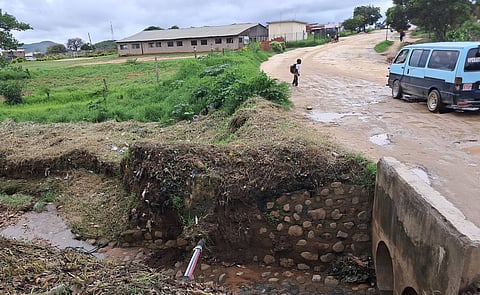

The climate of Zimbabwe, located in the heart of southern Africa, is changing rapidly, and for the worse.
Storms in the landlocked country of 17 million people are being edged on by this changing climate that brings either extreme droughts or floods. From 1970 to 2016, mean annual temperature has increased by about 0.03°C per year, according to Swiss researchers.
This year, Zimbabwe was affected by one of its worst floods. These followed a year where the worst drought in a century occurred in the country.
Even more worryingly, climate floodwaters in Zimbabwe are becoming deadly allies of urban rot. The changing climate is brewing a toxic mix of extreme weather and infectious diseases across urban Zimbabwe, Food and Agriculture Organization climate risilience consultant, Deogracious Kalima, warns.
This January, Darly Mbada considered himself the luckiest man in his neighbourhood of Glendale, a town 70 kilometres outside Harare, Zimbabwe’s capital.
“Ten days straight, l was in pain, cramps, blood in stool, and so much tiredness. It was cholera, and I have never been sicker,” said Mbada.
He is reminded of the horror of 2018 in Zimbabwe when cholera gobbled 4,287 lives.
The situation in the first month of 2025 across Zimbabwe was one of chaos. Mountains of uncollected trash, unsanitary public swimming baths, illegal water wells dug by residents because municipalities did not supply safe piped water, sewerage flowing in streets, unchecked destruction of wetlands, cities with no working fire or flood rescue teams — all this made climate storm waters a deadly ally of urban decay in the country.
A quick glance just outside Mbada’s five-room house revealed a blocked public sewer pipe that had been neglected for a year.
This reporter could discern from Mbada and his housemate Tavonga’s comments that the biggest carrier of diseases during extreme floods in Zimbabwe are shallow urban water wells dug without expertise and permits by thirsty residents.
The New Year’s floods leeched human faeces into water wells. Proper, safe free water supplies were (and are) rare in Zimbabwe’s cities. Few can afford to buy store-sterilised drinking water, said Mbada.
Jacqueline Revai, a nurse from Chiriseri clinic in Glendale, told Down To Earth (DTE) that city councillors in Glendale, like in many of Zimbabwe towns, no longer have concerns for duty and public health.
Even in Harare, the capital, corruption is deeply rooted. A judicial commission enquiry heard of hundreds of ghost workers, obsence salaries and wildly inflated contracts.
Revai, the nurse was frank: “In January, we were trying our best to give the sick salt and sugar fluids but we were unbelievably incapacitated by municipal authorities who did not bother to seal or unclog sewer drains.”
Mutare City, 400 km away, was also struck by climate-induced floods in January 2025. Clement Tshuma, a retired pastor, told DTE his soul was agonised by two tragedies in the city during that month — Devon Mvuduma,a 12-year-old schoolgirl swept away when rains flooded open sewerage ponds, and two grade four boys from Vimbai Primary School who died after getting stuck whilst swimming in a muddy pool.
All across Zimbabwe, it was (and is) the same story of political mismanagement of cities, urban decay and a climate crisis amplifying the danger.
“If our city had a working fire brigade division, those young souls would have had half a chance,” Tshuma said in a sympathetic voice.
Admire Jani, who has been a meteorologist in Mutare for the past 10 years before retiring, says mal-administration is behind the climate fatalities bedevilling the city.
“The exponential rate of change in weather patterns has made it difficult to protect human life. The heavy downpours (in January) were forecasted almost a month ahead of time. But still, basic drainage systems were not in place. Even the overflow that flooded schools in Sakubva, our biggest township in Mutare, had enough lead time to have not caused as much damage as it did,” he says.
To date, Mutare, with 220,000 residents, is supported by a sewer and water system designed for less than 60,000 residents by the British colonial government in the 1960s and 1970s, Jani says. Regardless, climate change does not spare the country. “Drainage routes that had been dusty for almost six months were suddenly expected to bear overflow in January,” he adds.
Mbada is clear: Zimbabwe’s municipal mismanagement and outright theft of public funds, are dovetailing with the climate, bringing the carnage onto residents’ doorsteps.
“Even a layman like me can see that these are preventable disease outbreaks or drownings,” he said.